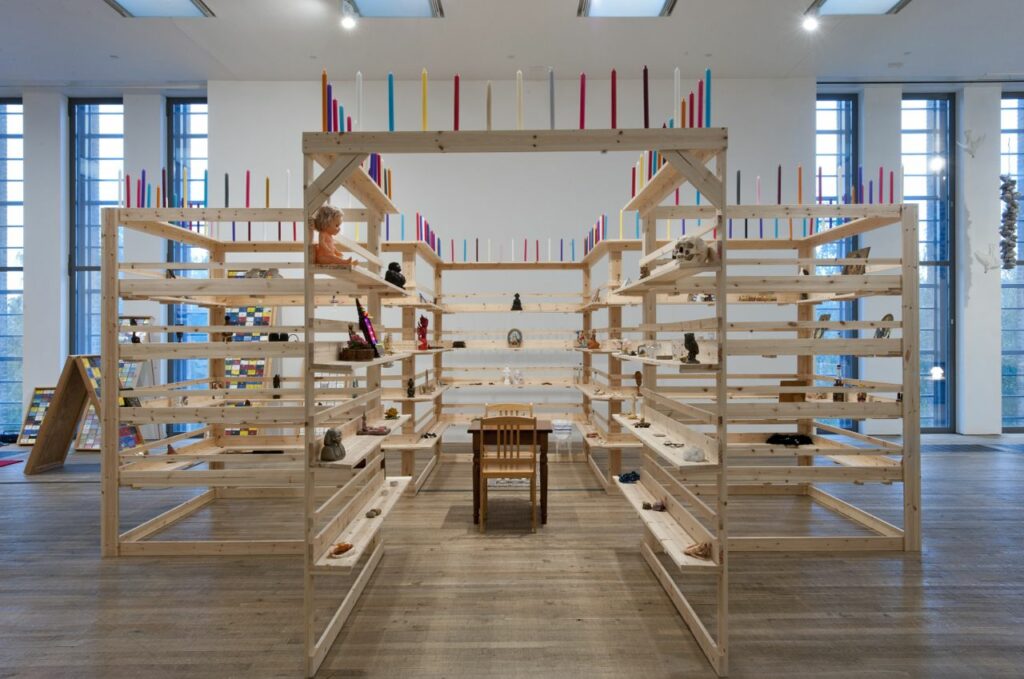Deutsche Bank KunstHalle, Berlin, Germany
20 Sep 2014 - 16 Nov 2014

Meschac Gaba, Art and Religion Room, from Museum of Contemporary African Art 1997-2002 Installation shot at Tate Modern, © Meschac Gaba © VG Bild-Kunst, Bonn 2014
“My museum has no walls,” says Meschac Gaba it is, “not a model… it’s only a question”. His twelve-room installation, acquired in 2012, is the largest single work Tate has purchased to date. The Museum of Contemporary African Art 1997-2002 has no permanent place, but has been shown temporarily in museums all around the world. Now, seven rooms from this seminal work will be on view for the first time in Berlin to mark the beginning of a co-operation between the Deutsche Bank KunstHalle and Tate Modern.
Gaba began working on this project between 1996 and 1997, when he first spent time in Europe on scholarship at the Rijksakademie in Amsterdam. The motivation for creating his own museum derived in part from the prevailing notion that contemporary African art simply did not exist. In the same spirit as artists associated with Relational Aesthetics, such as Felix Gonzalez-Torres and Rirkrit Tiravanija, Gaba was already using the exhibition context as an opportunity to create situations and places for social encounters where the meaning of an object is “activated” through its interaction with the viewer. Gaba also expanded the borderline areas between art, architecture, and design. Despite this, he felt Western curators were hesitant to see his work in this context. Moreover, Gaba was unable to imagine integrating his work into the canon of Western museums: “I needed a place for my work, because it didn’t yet exist.”
The first room he made was the “Draft Room,” which comes across as a preliminary sketch for his museum. A refrigerator containing discounted chicken parts, gilded loaves of bread, discarded food, a simple money-changer’s table and decommissioned banknotes from Benin, cut into dots, are displayed as if for sale: Gaba alludes here to the overabundance of the Western economy, in which things are frozen and wastefully discarded, while even chicken-feet are consumed in his experience. Inspired by his own reality of living between Holland and his native Benin in West Africa, Gaba’s museum playfully questions a variety of relationships: between Africa and the West, local and global, art and the everyday.
In the “Architecture Room,” the visitor can design his or her own museum building using wooden building blocks.
Spaces customarily found in a museum, such as a shop, restaurant and library are here transformed to include artists who are invited to contribute objects and prepare and host dinners for members of the public, In the “Art and Religion Room” objects and symbols of the world religions and different African religions are brought together with ordinary objects in a cross- shaped wooden structure, challenging their hierarchies and differences. The exhibition’s conclusion consists of the “Humanist Space” comprised of eight golden bicycles. Each of these bicycles is available for visitors to ride and transports the museum’s humanistic aims and cultural message into the city space.
FRAMEWORK PROGRAM
In the context of the exhibition, some rooms of the Museum of Contemporary African Art can be activated for and by visitors
Art and Religions Room – Tarot Card Readings Every Thursday and Sunday, 3 – 7 p.m.
The tarot card readings are free and take place without registration in the Art and Religion Room. Not for people under 18.
Humanist Space – Bicycle Tours
In the Humanist Space in front of the Kunsthalle, eight bicycles with the logo Museum of Contemporary African Art are available. On different tours of the city, the exhibition is extended to public space.
Public or Private Art?
Art in a Field of Tension Between Street Art, Museum as Institution, and Private Collection 21.09.2014, 3:30 p.m. – 6 p.m.
19.10.2014, 3:30 p.m. – 6 p.m.
16.11.2014, 3:30 p.m. – 6 p.m.
Religions in Berlin
Religious Diversity and Its Importance for the Development of the City, Its Art, and Its Architecture
05.10.2014, 3:30 p.m. – 6 p.m.
02.11.2014, 3:30 p.m. – 6 p.m.
Beginning and end: Deutsche Bank KunstHalle, Unter den Linden 13-15, 10117 Berlin
Registration: db.kunsthalle@db.com, +0049 (0)30-20 20 93 11
The tours are held in German. Subsequently, it is possible to participate in a free tour at 6 p.m.
Cost: € 10 (including tour, admission to the exhibition, and bicycle) Cost: € 8 (including tour and admission to the exhibition)
If desired, we will be glad to organize a bicycle tour in German, English, or French exclusively for you. (Price upon request). It is possible to rent the bicycles in the Humanist Space. Cost: € 5 euros an hour
Cooperation partner: berlinonbike
Museum Restaurant/Dinner Series
Dinner in Meschac Gaba’s Museum Restaurant
As part of the exhibition, on the following evenings guest artists will design, prepare, and host two dinners in Meschac Gaba’s Museum Restaurant.
Cost: € 40 euros per person, including drinks and a private tour of the exhibition from 6:30 p.m. to 7:30 p.m. More information is available at www.deutsch-bank-kunsthalle.de
Artist’s Talk 11/23/2014, 6 p.m.
Chris Dercon, Director of the Tate, talks with Meschac Gaba.
Kids- and Youthprogram
Accompanying each exhibition, the Deutsche Bank KunstHalle offers a large program for Children and Youths. You will find detailed information on the website
Deutsche Bank KunstHalle
Unter den Linden 13/15
10117 Berlin
www.deutsche-bank-kunsthalle.de